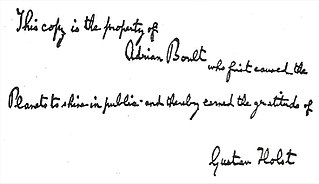
Liner notes are the writings found on the sleeves of LP record albums and in booklets that come inserted into the compact disc jewel case or cassette j-cards.

Optical disc packaging is the packaging that accompanies CDs, DVDs, and other formats of optical discs. Most packaging is rigid or semi-rigid and designed to protect the media from scratches and other types of exposure damage.

William Roger Dean is an English artist, designer, and publisher. He began painting posters and album covers for musicians in the late 1960s. The groups for whom he did the most art are the English rock bands Yes and Asia.

The Monty Python Instant Record Collection is the title of two compilation albums by the Monty Python troupe. The first was released in the UK and Canada in 1977 and drew from the group's first three studio albums, first live album, and first soundtrack album on the Charisma label, while the second was released in the US in 1981 and comprised tracks from their four albums released on the Arista label. Billed as "the pick of the best of some recently repeated Python hits again, Vol. II", the record sleeve was designed by Terry Gilliam. The UK/Canadian version originally featured packaging that folded out into a cardboard box resembling a large stack of record albums. An inner sleeve featured a spoof "Where Are They Now?" update on the members of the Python team.
Liner or LINER may refer to:

The Lion and the Witch is a live EP by American rock band Weezer. Recorded in Japan in the spring of 2002 while promoting Maladroit, released on September 24, 2002, exactly six years after the release of Pinkerton. It was distributed as a limited edition release in independently owned music stores with only 25,000 copies having been made. The album was then rereleased and remastered on vinyl in 2015, with only 3,000 copies made.

Muscle of Love is the seventh and final studio album by American rock band Alice Cooper. It was released in late 1973, the band played its last concert a few months later.

An album cover is the front packaging art of a commercially released studio album or other audio recordings. The term can refer to either the printed paperboard covers typically used to package sets of 10 in (25 cm) and 12 in (30 cm) 78-rpm records, single and sets of 12 in (30 cm) LPs, sets of 45 rpm records, or the front-facing panel of a cassette J-card or CD package, and, increasingly, the primary image accompanying a digital download of the album, or of its individual tracks.

Motörhead is the debut studio album by English rock band Motörhead. It was released on 12 August 1977 by pub rock and early punk rock label Chiswick Records, one of the first for the label, and the band's only release under Chiswick. The album contains the "classic" Motörhead line-up of Lemmy Kilmister on bass and vocals, "Fast" Eddie Clarke on lead guitar, and Philthy Animal Taylor on drums. The sleeve artwork featured the debut of Snaggletooth, the War-Pig, the fanged face logo created by artist Joe Petagno that would become an icon of the band.

10 from 6 is a compilation album released by English supergroup Bad Company in December 1985 on Atlantic Records label. All the songs on the album were previously released on Swan Song Records, a record label begun by Led Zeppelin in 1974. The title refers to the album's 10 songs taken from the six albums Bad Company had recorded to that time, though no songs from Burnin' Sky appear on the album.
A promotional recording, promo, or plug copy is an audio or video recording distributed free, usually in order to promote a recording that is or soon will be commercially available. Promos are normally sent directly to broadcasters, such as music radio and television stations, and to tastemakers, such as DJs, music journalists, and critics, in advance of the release of commercial editions, in the hope that airplay, reviews, and other forms of exposure will result and stimulate the public's interest in the commercial release.

The Transfiguration of Blind Joe Death is a 1965 album by American fingerstyle guitarist and composer John Fahey. Originally issued in a hand-lettered edition of 50, it was Fahey's first album to be released by a label other than his own Takoma Records. As with all of Fahey's independently released early albums, it had little critical recognition upon release. The album has grown in stature since its reissue on CD in 1997 and is now highly regarded critically. It was Fahey's fourth album to see release, though after his fifth album, The Great San Bernardino Birthday Party & Other Excursions, was labeled Guitar Vol. 4, reissues of The Transfiguration of Blind Joe Death were subtitled John Fahey, Volume 5.

"D.D.D." is a song recorded by Japanese recording artist Kumi Koda, taken from her second greatest hits album, Best ~second session~ (2005). It contains guest vocals from Japanese music duo Soulhead. It was written by Soulhead members and sisters Yoshika and Tsugumi, with production being done by Octopussy. The song is Kumi's first collaborative effort since her single "Hot Stuff" with Japanese rapper KM-MARKIT, which was released a month prior. As part of Kumi's 12 Singles Collection releases, "D.D.D." premiered on December 21, 2005, as the third single from the album. The CD cover sleeve has Kumi wearing a black mini-dress and headdress. The cover sleeve is to represent the country United Kingdom, and its symbolism of Britannia.

Midnight in San Juan is the second solo album by British blues rock musician Danny Kirwan, who was a member of Fleetwood Mac from 1968–72. Released in 1976, this was his second of three solo albums with the DJM Records label.

Emergency Ward! is a 1972 album released by Nina Simone. The title of the record is rendered as "Emergency Ward" on the record label itself, but as "Emergency Ward!" on the cover sleeve. The sleeve also bears the text "Nina Simone in Concert". The album is considered to be Simone's statement on the Vietnam War and has been described as "consistently thrilling" by AllMusic's Mark Richardson.

Perfume: Complete Best is the first greatest hits album by Japanese girl group Perfume. It was released on August 2, 2006 by Tokuma Japan Communications. The greatest hits album includes work released from their previous record label Bee-hive Records, and previous work with Tokuma Japan Communications. The album also included b-side and one newly recorded track. It was released in three different formats; a CD and DVD bundle, a digital release, and a double 12-inch vinyl LP. The LP was released through Perfume's February 2016 box set Perfume Complete LP Box, and a singular limited release.
In the production of phonograph records – discs that were commonly made of shellac, and later, vinyl – sound was recorded directly onto a master disc at the recording studio. From about 1950 on it became usual to have the performance first recorded on audio tape, which could then be processed and/or edited, and then dubbed on to the master disc.

Live in New York is the final album recording by the American country blues musician Mississippi Fred McDowell. New York-based American independent Oblivion Records released the first edition in the Spring of 1972, months before McDowell's death in July 1972. A subsequent Oblivion issue with a one song substitution, and new and redesigned liner notes came out one year later.

Blues from the Apple, released in 1974 by Oblivion Records, is the only album under the leadership of guitarist and vocalist Charles Walker. Featured players include New York City based musicians Lee Roy Little, Bill Dicey (harmonica), 'Foxy' Ann Yancey, Larry Johnson (harmonica), Tom Pomposello, Bobby King, and Ola Mae Dixon (drums), among others.
Between 1993 and 2000, a series of Ramones covers albums were released by Selfless Records, an independent record label based in Garland, Texas specializing in punk rock, on which bands influenced by seminal punk group the Ramones performed cover versions of entire Ramones albums. Under the Selfless label, Screeching Weasel, the Queers, and the Vindictives respectively covered the first three Ramones albums: Ramones (1976), Rocket to Russia (1977), and Leave Home (1977). Selfless then became Clearview Records and continued the series, with Boris the Sprinkler, the Parasites, the Mr. T Experience, the Beatnik Termites, and the McRackins respectively covering End of the Century (1980), It's Alive (1979), Road to Ruin (1978), Pleasant Dreams (1981), and Too Tough to Die (1984).
















